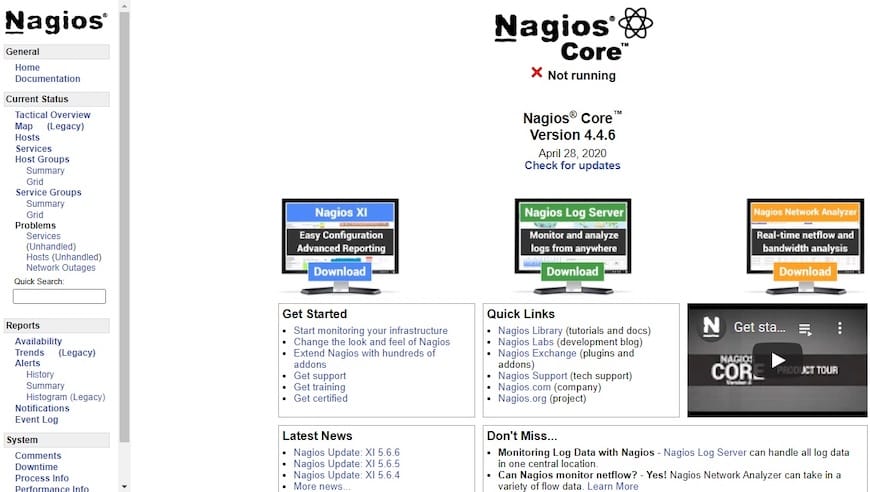How To Install Nagios on AlmaLinux 9

In today’s complex IT environments, monitoring infrastructure is crucial for maintaining system health and preventing downtime. Nagios, a powerful open-source monitoring system, stands out as a reliable solution for tracking the status of network services, hosts, and servers. This guide will walk you through the process of installing Nagios on AlmaLinux 9, a robust enterprise-grade Linux distribution.
Nagios offers real-time alerts, performance tracking, and comprehensive reporting capabilities, making it an indispensable tool for system administrators and IT professionals. By following this step-by-step tutorial, you’ll be able to set up Nagios and start monitoring your IT infrastructure effectively.
Prerequisites
Before diving into the installation process, ensure you have the following:
- An AlmaLinux 9 server with root access or a non-root user with sudo privileges
- SELinux set to permissive mode (we’ll cover this in the guide)
- A stable internet connection for downloading packages
- Basic familiarity with Linux command-line operations
It’s crucial to have these prerequisites in place to ensure a smooth installation process. Let’s begin by preparing your AlmaLinux 9 system for Nagios.
Step 1: Update System Packages
Before installing any new software, it’s essential to update your system’s existing packages. This practice ensures compatibility and security. Open your terminal and run the following command:
sudo dnf update -yThis command updates all installed packages to their latest versions. The ‘-y’ flag automatically answers “yes” to any prompts, streamlining the update process.
Step 2: Install EPEL Repository
The Extra Packages for Enterprise Linux (EPEL) repository is a valuable resource for additional software packages not included in the default AlmaLinux repositories. Nagios and some of its dependencies are available through EPEL.
To install the EPEL repository, execute:
sudo dnf install epel-releaseAfter installation, refresh your package cache:
sudo dnf makecacheThis step ensures that your system is aware of the newly available packages from EPEL.
Step 3: Install Nagios Core
With the EPEL repository in place, we can now proceed to install Nagios Core and its essential components. Run the following command:
sudo dnf install nagios nagios-common nagios-plugins nagios-plugins-all nrpeThis command installs Nagios Core, common utilities, plugins, and NRPE (Nagios Remote Plugin Executor). The installation process may take a few minutes, depending on your internet speed and system performance.
During the installation, you might be prompted to confirm the installation of additional dependencies. Type ‘y’ and press Enter to proceed.
Step 4: Configure Nagios Core
After installation, it’s time to configure Nagios Core. This step involves setting up authentication, adjusting default settings, and verifying the web server configuration.
First, let’s set up a password for the Nagios web interface:
sudo htpasswd -c /etc/nagios/passwd nagiosadminYou’ll be prompted to enter and confirm a password. Remember this password, as you’ll need it to access the Nagios web interface.
Next, we need to configure Apache to serve the Nagios web interface. Create a new configuration file:
sudo nano /etc/httpd/conf.d/nagios.confAdd the following content to the file:
ScriptAlias /nagios/cgi-bin "/usr/lib64/nagios/cgi-bin"
<Directory "/usr/lib64/nagios/cgi-bin">
Options ExecCGI
AllowOverride None
Require all granted
<IfModule mod_authz_core.c>
# Apache 2.4
Require all granted
</IfModule>
<IfModule !mod_authz_core.c>
# Apache 2.2
Order allow,deny
Allow from all
</IfModule>
</Directory>
Alias /nagios "/usr/share/nagios/html"
<Directory "/usr/share/nagios/html">
Options None
AllowOverride None
Require all granted
<IfModule mod_authz_core.c>
# Apache 2.4
Require all granted
</IfModule>
<IfModule !mod_authz_core.c>
# Apache 2.2
Order allow,deny
Allow from all
</IfModule>
</Directory>Save the file and exit the editor.
Now, restart Apache to apply the changes:
sudo systemctl restart httpdStep 5: Start and Enable Nagios Service
With the configuration in place, it’s time to start the Nagios service and enable it to run at system boot:
sudo systemctl start nagios
sudo systemctl enable nagiosTo verify that Nagios is running correctly, check its status:
sudo systemctl status nagiosYou should see output indicating that Nagios is active and running.
Step 6: Install Nagios Plugins
Nagios plugins extend its functionality, allowing you to monitor a wide range of services and systems. While we installed some plugins earlier, you might want to add more based on your specific monitoring needs.
To browse available plugins, use:
sudo dnf search nagios-pluginsInstall additional plugins as needed. For example, to install SNMP plugins:
sudo dnf install nagios-plugins-snmpRemember to restart Nagios after installing new plugins:
sudo systemctl restart nagiosStep 7: Verify Installation
To ensure Nagios is installed correctly and running, perform these verification steps:
1. Check the Nagios service status:
sudo systemctl status nagiosLook for “Active: active (running)” in the output.
2. Verify Nagios configuration:
sudo /usr/sbin/nagios -v /etc/nagios/nagios.cfgThis command checks for configuration errors. If there are no errors, you’ll see “Total Warnings: 0” and “Total Errors: 0” at the end of the output.
3. Test Apache configuration:
sudo apachectl configtestYou should see “Syntax OK” if the configuration is correct.
If you encounter any issues during verification, review the previous steps and check the Nagios and Apache error logs for more information:
sudo tail -f /var/log/nagios/nagios.log
sudo tail -f /var/log/httpd/error_logAccessing Nagios Web Interface
With Nagios installed and running, you can now access its web interface:
1. Open a web browser and navigate to:
http://your_server_ip/nagiosReplace “your_server_ip” with your AlmaLinux 9 server’s IP address or domain name.
2. You’ll be prompted for authentication. Use the username “nagiosadmin” and the password you set earlier.
3. Once logged in, you’ll see the Nagios dashboard. Take some time to explore the various sections:
- Tactical Overview: Provides a summary of your monitored services and hosts
- Map: Displays a visual representation of your network
- Services: Lists all monitored services and their current status
- Host Groups: Shows groups of monitored hosts
- Reports: Offers various reporting options for system status and performance

Configuring Nagios
Now that Nagios is up and running, you’ll want to configure it to monitor your specific infrastructure. Here are some key configuration files to be aware of:
/etc/nagios/nagios.cfg: Main configuration file/etc/nagios/objects/commands.cfg: Defines check commands/etc/nagios/objects/contacts.cfg: Configures notification contacts/etc/nagios/objects/timeperiods.cfg: Sets monitoring time periods/etc/nagios/objects/templates.cfg: Contains templates for hosts and services
To add new hosts or services to monitor, create new configuration files in the /etc/nagios/conf.d/ directory. For example:
sudo nano /etc/nagios/conf.d/myserver.cfgAdd your host and service definitions to this file. Here’s a basic example:
define host {
use linux-server
host_name myserver
alias My Linux Server
address 192.168.1.100
max_check_attempts 5
check_period 24x7
notification_interval 30
notification_period 24x7
}
define service {
use generic-service
host_name myserver
service_description PING
check_command check_ping!100.0,20%!500.0,60%
}After making changes to any configuration files, always verify the configuration and restart Nagios:
sudo /usr/sbin/nagios -v /etc/nagios/nagios.cfg
sudo systemctl restart nagiosTroubleshooting Tips
If you encounter issues with Nagios, try these troubleshooting steps:
1. Check Nagios logs for error messages:
sudo tail -f /var/log/nagios/nagios.log2. Verify SELinux is not blocking Nagios:
sudo setenforce 0If Nagios starts working, you may need to configure SELinux policies for Nagios.
3. Ensure all required ports are open in your firewall:
sudo firewall-cmd --permanent --add-service=http
sudo firewall-cmd --reload4. Verify file permissions:
sudo chown -R nagios:nagios /etc/nagios
sudo chmod -R 775 /etc/nagiosCongratulations! You have successfully installed Nagios. Thanks for using this tutorial for installing the Nagios open-source monitoring on AlmaLinux 9. system. For additional help or useful information, we recommend you check the Nagios website.